
Editor’s note: this second look is based on the workshop production, the new run of Rochester, 1996 began this past weekend in LA. This deep dive contains MAJOR SPOILERS for the show in the interests of analysis.
As Rochester, 1996 heads into its third act, there’s a moment that’s a quiet revelation. The moment is as shocking as the show gets and the explicit direction only serves to highlight just how understated everything else that leads up to it is. Those subtle hands that guide the script, the direction, and the performances are what allows the show to deftly play with the language of immersive theatre itself to tell the story of Phillipa’s awakening.
While the movement into the third act is the most obvious instance of Capital W and DryCræft Los Angeles playing with those forms, this is something that runs through all of Rochester, 1996. The show uses shifts in style and the audience’s perspective, the kind of techniques that immersive theater is exceptionally suited for, to illuminate and hide the inner lives of a daughter and father in upstate New York.
It all begins in a tiny, walled off room, at least for Phillipa. She’s spent the last year or so building up those walls to keep her shame, her fear, and her desires away from the eyes of her parents. The audience is allowed a glimpse of Phillipa’s turmoil inside a small, cramped room that mimics her feelings while setting the stage for the rest of the story. The style and tone of this short scene are starkly different from the natural feel of the rest of show, but that strangeness pays off, bonding the audience to Phillipa. When the hymns float in from the next room, they’re strange, almost alien, and they capture what it must have been like in Phillipa’s head for the last year.
As the show transitions into its first proper scene, the audience changes perspectives and immersive styles right along with it. Everyone moves into a church service that feels like a real church service. From the friendly greetings to the hymns to the sermon on Psalm 139, and even the kudos awarded to selected audience members, Rochester, 1996 works to make the audience feel like part of the Tree of Love congregation. That serves the immersive nature of the show, of course, but it’s also key to how the creators try to position those immersive elements to enhance the story rather than just making the audience feel present inside it.

Throughout the scene, each of the parishioners only offers up what they want people to see of themselves, though some are more obviously guarded than others. Daniel, Phillipa’s father and the pastor of Tree of Love, has built his own walls up. Even as he opens his heart to his church, there are moments where he tries to keep to himself. When a visiting seminary student asks him about a gay friend, Daniel is careful with his words and avoids condemning the gay man, neither does he rebuke the seminary student. As that moment passes, his bright and cheerful disposition returns; that’s all the audience is allowed to know.
Phillipa, despite being the audience’s clear anchor point, is deliberately sidelined, literally and figuratively for this section of the performance. She plays the dutiful role of a PK (pastor’s kid), while struggling with the very idea of what that and her religion means when contrasted with her burgeoning identity as a young, gay woman. Those realizations are only hinted at here in Phillipa’s asides to the audience, a device that becomes more prominent in the second act.
The show uses the immersive format of the scene to not just place attendees in the role of churchgoers, but to focus what they learn about the characters in Rochester, 1996 through that lens. This surface level understanding of these people will be peeled back as the audience moves further into the parishioners’ inner lives. To that end, Phillipa pauses the action at the church and moves the audience into the next immersive phase where they’ll act as something akin to her journal, experiencing (almost) everything from her perspective.
Here again, the creators wisely use the transformed format in this, the second act of the show to emphasize Phillipa’s feelings and understanding of her dad. They carefully position Daniel in the driver’s seat, Phillipa in the middle of the van, and the audience in the backseat. This creates a distance and a physical wall that means the audience can’t get close to Daniel. Sure, everyone can find him compelling, funny, and endearing but their notebooks on his inner workings will remain as empty as Phillipa’s.
Despite the indie movie vibe mentioned in NoPro’s review being in full effect as Daniel and Phillipa chat and banter on their ride home from church, Daniel is almost completely isolated from everyone. His guarded nature is physicalized by his location relative to everyone in the van. The only small window provided into his thoughts is through his eyes, courtesy of an extra-large rear-view mirror deliberately installed so each attendee can see him clearly. Here we see space being used as a vehicle for story.
The only time they’ll be able to truly see him for who he is though, are in two major moments when he steps outside of the car.
In the park where the Shoemakers stop to pick up Nadia, Daniel hugs the despondent woman. While he hugs her, his walls come down ever so slightly. Phillipa is preoccupied with helping Nadia and contending with her own feelings while this is happening, so it’s no surprise that she and the audience might not catch it. Indeed, Nadia’s addition to the van is the first crack in the relationship between father and daughter.
Get Kevin Gossett’s stories in your inbox
Join Medium for free to get updates from this writer.
SubscribeSubscribe
Phillipa is all a flutter because of the woman; she wants to help her, but at the same time is enraptured by her hair and what it means to her. It brings back those feelings and moments of recognition from a year ago. She began building up her walls to prevent those same feelings, but they threaten to break through all the same.
As Phillipa is caught up in her feelings through this sequence, the audience is likely to get caught up right along with her. In something of a magic trick, Daniel’s presence and actions are obfuscated by Phillipa’s excitement. When she finally comes back to earth (and the audience with her), she watches her father comfort Nadia and then connects the dots. She immediately begins questioning Daniel, but his feeble defenses tell the story.
He pulls the car over again, everything he’s hidden behind his own walls has curdled, and he throws it all up. As Phillipa and the audience watch from the car, despite the distance, she’s able to see him more clearly than she ever has. After a war of words between the two, the rest of the ride home is silent. Phillipa’s relationship with her father and her whole world view are strained under these revelations.
Upon arriving at the Shoemaker’s house, everything breaks, from the father and daughter’s relationship right down to the very rules of Rochester, 1996. Phillipa pauses the action, “You can follow me inside. You can stay here with my father. Do whatever you want, nothing matters anymore.” While the show has to call attention to the moment out of necessity, it does so while managing to make sure it still feels a piece with the Phillipa the audience has gotten to know. All while blending the immersive format shift with Phillipa’s emotional state. That’s some tricky stuff.
Rochester, 1996 takes advantage of the shift into a free roam style (and one where Phillipa no longer has asides with the audience) to capture the chaos in the Shoemaker home. The dive into the family’s inner lives is complete and everything is laid bare. Daniel’s walls have crumbled and his composure is gone, the consequences of his actions slowly seep out. Phillipa is adrift and angry, but still manages to hold on to her kindness as she helps Nadia get cleaned up, indulging in her schoolgirl crush as she sets a stuffed animal on the bed for her. The audience is caught in the middle of it all, trying to make sense of everything.
Amidst crumbling relationships, Phillipa speaks with the audience again. She can’t take it anymore, she can’t keep holding everything in behind the walls she’s been building.
It all ends outside where Phillipa can feel the air and the sun, free of the pressures and away from the walls. Everything here holds a mirror up to where the show began. Instead of a cramped room, there’s openness of the sun and the sky. Instead of a cryptic speech about her pain, Phillipa speaks plainly about the course her life will run. Instead of boxing her in, the audience stands casually in front of her.
She has recognized the necessity of tearing down the walls and she experiences the clarity that comes with doing so. By setting this scene outside, Phillipa’s new mindset is emphasized to the audience. There’s music once again, but this time it’s friendly and gentle, it guides everyone out into the world.
—
Rochester, 1996 does something unique as far as immersive theatre is concerned: It doesn’t focus on casting the audience as a protagonist or someone experiencing their own journey through a world.
This specific story is a testament to what can happen when all of the pieces of immersive theatre are pulled together. It doesn’t just use immersive elements, or interactivity, or a unique location, or a fascinating story. Rochester, 1996 uses everything in conjunction with each other to make sure Phillipa’s story resonates with the audience in the strongest possible way. You’re able to feel what’s happening to her not because it’s happening to you physically, but because it puts you into her headspace while letting you watch her at the same time. The walls between the Shoemakers, the intoxicating quality of Nadia’s hair, and so many other things make such a big impact because of how the immersive part of the show and the story part of the show function in unison. That fusion feels like the next step forward in immersive theatre and Rochester, 1996 should serve as a master class.
Rochester, 1996 is now playing in Los Angeles. While the September set of tickets is sold out, individual slots may be released on a weekly basis, and those interested in extensions should sign up at the Capital W website.
NoPro is a labor of love made possible by:

…and our generous Patreon backers: join them today!
In addition to the No Proscenium web site, our podcast, and our newsletters, you can find NoPro on Twitter, Facebook, YouTube, Instagram, in the Facebook community Everything Immersive, and on our Slack forum.

















Discussion